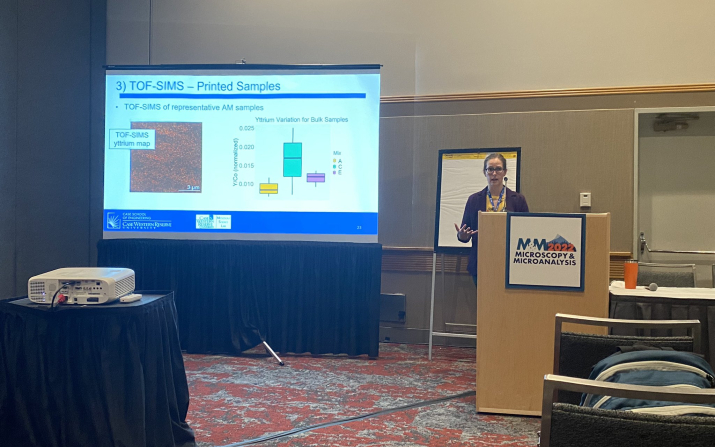Pigott, Wilson present at Microscopy & Microanalysis

Case Western Reserve University was well represented at the annual Microscopy & Microanalysis conference in Portland, Ore. Laura Wilson, a Ph.D. candidate in the Department of Materials Science and Engineering, gave an oral presentation, while Jeffrey Pigott, Executive Director of Swagelok Center for Surface Analysis of Materials, gave a poster presentation.
Wilson used her SCSAM fellowship research as a base for her oral presentation and extended abstract, “Quick and Correlative TOF-SIMS Analysis of Dispersoid Content in Powder Feedstock and Printed Oxide Dispersion Strengthened Alloys.” Wilson’s presentation, which Pigott described as “fantastic,” focused on using TOF-SIMS to assess quality of both oxide coating and distribution for oxide dispersion strengthened powder preparation methods for laser powder bed fusion additive manufacturing. Analyzing samples made at NASA Glenn Research Center at SCSAM, Wilson learned techniques for working with beam-sensitive samples and about new scanning electron microscopes and focused ion beam equipment. The speaker following Wilson at her presentation session focused on a similar technique and made several references to Wilson’s talk, saying that it was a great introduction to their own.
Pigott presented his poster, “Broad Applications of Scanning Electron Microscopy and Energy-Dispersive Spectroscopy in Art Conservation,” at the Aug. 3 poster session. He focused on his collaborations with eight co-authors from the Cleveland Museum of Art (CMA) Conservation Department to translate scientific microscopy to art conservation and outreach. The specifics are available on the poster, which will be displayed in SCSAM, and corresponding extended abstract published in Microscopy & Microanalysis.
Since SCSAM acquired their ThermoFisher Apreo 2S (NSF: 2018167), conservators from the CMA have worked with Pigott to use the microscope to examine small cross-section samples from paintings and sculptures, pendants and figurines, and thread from a tapestry. One of Pigott’s most notable contributions to this collaboration was analyzing a thread from a 17th-century French tapestry that the Museum hadn’t displayed since the museum acquired it 70 years ago. The aforementioned tapestry is now part of the Museum’s Cycles of Life: The Four Seasons Tapestries exhibit which includes a booklet intended to educate the public about textile conservation. The booklet included an image and results from the SEM/EDS analysis, thus exposing a new audience to the importance of electron microscopy in characterizing materials.
Throughout the two-hour session, Pigott had a stream of conference attendees at his poster. “People told me this was a unique application and presentation,” said Pigott. “Everyone I talked to thought it was really interesting.”
Since Pigott and Wilson each only gave their presentations at one session each, they were both able to attend the conference’s daily oral presentations, poster sessions, vendor exhibits, workshops, and networking events. One of Wilson's favorite presentations was from a plenary speaker who talked about science communication and challenged attendees to come up with an action movie title for their research. She was intrigued to discover that one can get crystal orientation and chemical data from light microscopes, and she also enjoyed hearing about cryo-TEM of biological samples, microprobe research of geologic samples and informatics with old equipment.
Pigott felt that the conference benefitted him as both a researcher and a facility director. Since SCSAM will begin developing volumetric electron microscopy capabilities, where three-dimensional data are reconstructed from scanning electron microscope images, in the fall, he went to several presentations focusing on that particular topic. He also attended a session focused on generating, increasing and sustaining user engagement at core facilities.
Wilson and Pigott agreed that attending an in-person conference creates an experience one cannot get at a virtual conference. Pigott appreciated getting to meet up with old friends from the microscopy community, as well as meeting new people. Wilson also believes she made a significant amount of connections and enjoyed interacting with different vendors at the conference and seeing their equipment. Outside of the engineering arena, she enjoyed getting to visit the International Rose Test Garden and the world’s largest independent bookstore, Powell’s Books.
Hosted by Microscopy Society of America and Microanalysis Society, the former of which Pigott is a board member for the Northeast Ohio chapter, the conference drew ~4,000 attendees from across the United States and around the world. As a member of the Microscopy Society of Northeast Ohio board, Pigott will soon start planning a regional in-person conference to be held at John Carroll University in May 2023, as well as social and networking events throughout the 2022-23 academic year.

